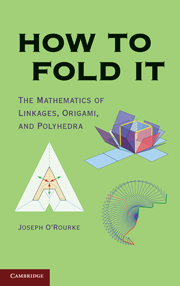PART I - Linkages
Published online by Cambridge University Press: 05 June 2012
Summary
Linkages are mechanisms built from stiff, inflexible bars, which we will call rigid links, connected at freely rotating joints. You may have a linkage on your desk similar to the one depicted in Figure I.1. Many machines contain linkages for particular functions. Every car contains a crankshaft, a mechanism for converting the linear motion induced from the sparked explosion of gasoline in a piston chamber to the rotary motion turning the drive shaft. We'll explore three linkages, each with a clean mathematical story to tell, and each related to developments on the frontiers of mathematics and computer science today: robot arms, pantographs, and fixed-angle chains. We'll analyze the “reachability region” for robot arms viewed as a linear chains of links. The pantograph is a mechanical copying and enlarging mechanism with myriad uses, especially during the industrial revolution. Fixed-angled chains are superficially similar to robot arms, but are primarily of interest as models of protein backbones.
Although here we are emphasizing the relevance of these linkages, our focus will be on the mathematics behind their operation.
- Type
- Chapter
- Information
- How to Fold ItThe Mathematics of Linkages, Origami, and Polyhedra, pp. 1 - 2Publisher: Cambridge University PressPrint publication year: 2011



